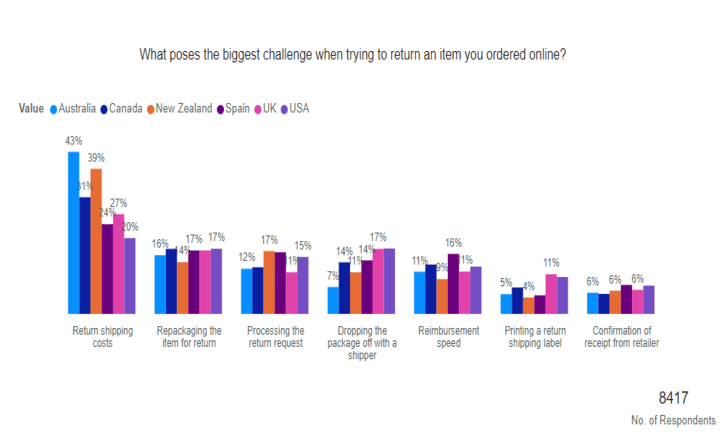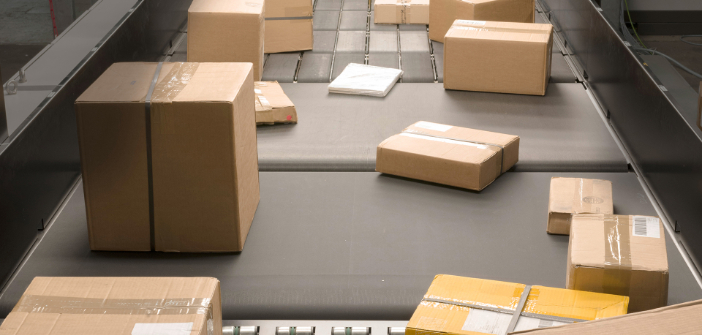Right now, we’re in the midst of a peak like no other, with demand for delivery outstripping capacity in most countries around the world. That means in January of this year, we are going to see record numbers of returns – our analysis suggests 70% to 80% higher than we’ve previously seen. Because returns can be complex and costly, it will be important to get this right.
More e-commerce means more returns
The Covid-19-driven growth in e-commerce has really raised the stakes for retailers’ returns processes. We know, for example, that customers who buy online are three times more likely to return an item than those who buy in store. On top of that, you have to consider the massive acceleration in digital commerce seen during the Covid-19 pandemic. As I’ve written previously, we can expect ecommerce volumes to stay about 30% higher than pre-pandemic levels for the foreseeable future.
This means more returns for retailers to handle. If you consider the practice of bracketing, you can see why. Bracketing involves buying more items than you need online, or buying the same item in different sizes, then sending back the ones you don’t want. With Covid-19 restrictions making trying on in stores impossible, the inevitable outcome of all these new e-commerce purchases is more returns as consumers turn to bracketing to find what they need.
I’ve seen this myself during lockdown. As I write this, I’ve got five pairs of jeans in my house ready to go back. I can’t be the only one who isn’t sure of their size anymore after eight months of pandemic.
More emphasis on the returns experience
On top of these higher volumes, retailers also now have to contend with higher consumer expectations about the whole returns experience. Research shows, for example, that three in five shoppers review a retailer’s returns policy before buying. And almost half say they’ve been deterred from making a purchase by what they find.

The good news is that most retailers understand the value of a streamlined returns experience. In fact, a recent Accenture survey showed that, overall, retailers think simple to use returns is the second most important e-commerce feature for their future growth —interestingly more so than free shipping.
Three ways posts can help streamline returns
The question for post and parcel organizations is how they can support retailers in making returns as fast, friction free, and cost-effective as possible. There are three areas in particular to look at.
#1. The first is enabling dynamic friction. This means supporting retailers’ ability to dial up and down, for different customers or customer segments, the simplicity of making a return.
At the heart of this is one counterintuitive but important fact: a retailer’s most valuable customers are typically responsible for the most returns. Research shows the highest quartile of returning customers produce 22-46% more profit on average after six months.
For these high-value customers, you need to make returns as easy as possible. The faster you can process a return and make a refund, the more likely they’ll spend that money with your company. At the same time, you’ll still want to be able to deter any low-value serial returners in your customer base.
Having the ability to dynamically eliminate or increase friction based on who the customer is, and how much value they represent, will be increasingly important. And post and parcel organizations need to be able to play their part in supporting that.
#2. The second area is dynamic routing. Delivery organizations should be looking to make it easier for retailers to get returned inventory back to where they need it. And that, again, needs to be a dynamic capability, this time based on what the product is and where it’s coming from.
Some products will need to go to the distribution center, some to the local store, and others will simply need to be disposed of. If someone is returning a US$3 phone case, for instance, it’s going to cost the retailer more to process than the product is worth. So offering a dynamic disposition capability (destruction, wholesale, etc.) is another key element of a returns solution.
#3. Post and parcel organizations should also be looking at developing new end-to-end returns offerings. For example, returning an item should be as simple as answering a question or two on an app. Customers could bring these items to a retail outlet, provide their email address and where they bought the item and have their money back before they walk out the door. The receiving store will then do a quick triage and confirm the return.
Any post and parcel organizations should be capable of doing something like this. What’s more, thanks to their existing networks, posts are ideally placed to go further and let customers request a pickup directly from the home. Done right, that’s a remarkable new kind of offering that cuts out a great deal of friction in the current returns process.


